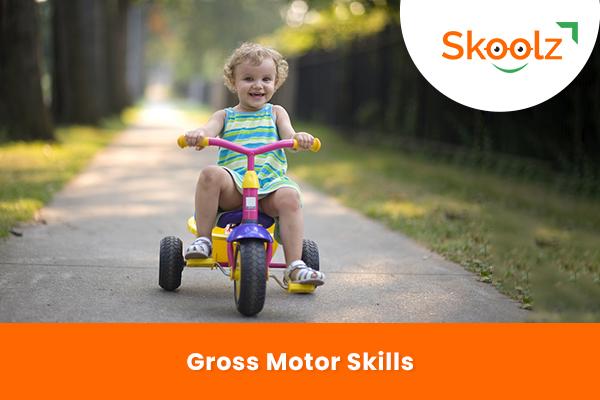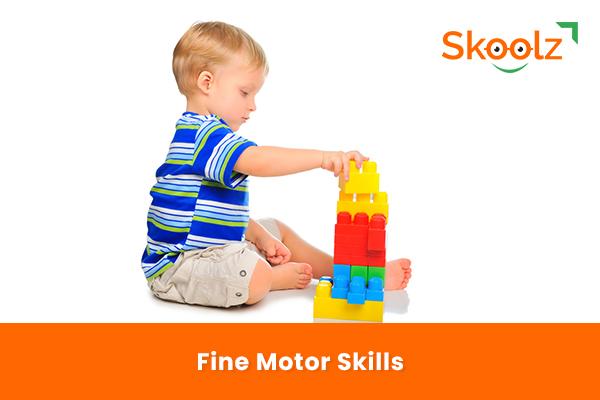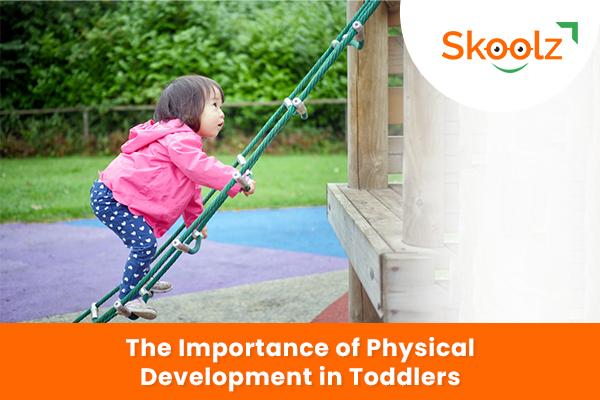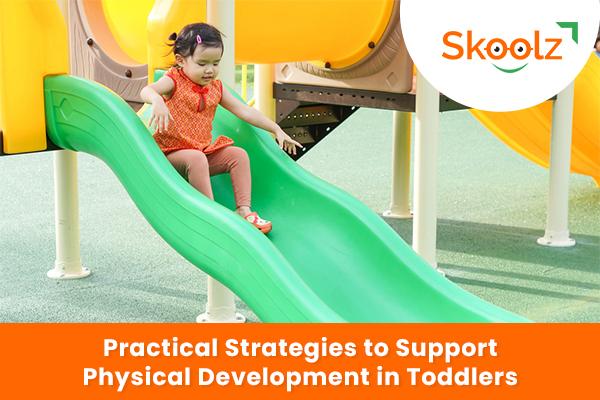
On the Move: Nurturing Physical Development in Toddlers
On the Move: Nurturing Physical Development in Toddlers
Physical development is a key aspect of a toddler's growth, encompassing the development of their gross and fine motor skills. It is during this stage that toddlers learn to explore their environment, gain control over their bodies, and develop essential physical abilities. In this blog, we will delve into the importance of physical development in toddlers, explore the different milestones, and provide practical strategies to support and enhance physical skills during this critical stage of early childhood.
Physical development is a critical aspect of toddlers' overall growth and well-being. During this stage, toddlers undergo significant changes in their gross motor skills (larger movements involving the whole body) and fine motor skills (smaller movements involving the hands and fingers).
Here are some key areas of physical development for toddlers:
Gross Motor Skills:

1. Walking and Running:
Toddlers typically transition from crawling to walking independently during this stage. They gain better control over their leg muscles and gradually improve their balance and coordination.
2. Climbing and Balancing:
Toddlers enjoy climbing stairs, playground structures, and furniture. They develop their ability to balance, supporting their overall strength and coordination.
3. Jumping and Hopping:
Toddlers begin to jump off the ground with both feet and experiment with hopping on one foot. These activities enhance their leg strength and coordination.
4. Throwing and Kicking:
Toddlers start practicing throwing and kicking balls, developing their hand-eye coordination and improving their arm and leg muscles' strength.
5. Riding a Tricycle:
Toddlers can start learning to pedal a tricycle, which further enhances their leg strength and coordination while introducing the concept of steering and controlling a vehicle.
Fine Motor Skills:

1. Grasping and Releasing Objects:
Toddlers refine their ability to grasp objects using their fingers and thumb, transitioning from a palmar grasp to a more refined pincer grasp. They can manipulate objects more effectively and practice tasks like stacking blocks or fitting shapes into corresponding holes.
2. Scribbling and Drawing:
Toddlers engage in scribbling and basic drawing activities using crayons or markers. This promotes hand-eye coordination, fine motor control, and creativity.
3. Self-Feeding:
Toddlers develop the ability to feed themselves using utensils like spoons and forks. They improve their hand-eye coordination and fine motor skills as they learn to scoop, stab, and bring food to their mouths.
4. Self-Dressing:
Toddlers begin to practice self-dressing skills, such as pulling on and taking off simple garments like shirts, pants, and socks. This promotes independence, fine motor control, and body awareness.
5. Manipulating Small Objects:
Toddlers engage in activities that involve manipulating small objects, such as puzzles, building blocks, and threading beads. These tasks refine their hand-eye coordination, finger dexterity, and problem-solving skills.
Encourage physical development in toddlers by providing ample opportunities for active play, both indoors and outdoors. Offer age-appropriate toys, play equipment, and activities that challenge their motor skills and coordination. Provide a safe and supportive environment for exploration and practice. Remember that each child develops at their own pace, so be patient and supportive and celebrate their progress along the way.
The Importance of Physical Development in Toddlers:

Physical development plays a vital role in a toddler's overall growth and well-being. Here are some reasons why it is crucial:
1. Motor Skills:
Physical development helps toddlers acquire and refine their motor skills. Gross motor skills, such as crawling, walking, and running, enable them to explore their surroundings and engage in physical activities. Fine motor skills, such as grasping objects, using utensils, and buttoning clothes, contribute to their independence and self-help abilities.
2. Strength and Coordination:
Physical activities and playtime promote the development of muscle strength and coordination. As toddlers climb, jump, and play with toys, they develop their core strength, balance, and coordination, which are essential for various daily activities and sports in the future.
3. Body Awareness and Spatial Skills:
Through physical development, toddlers gain a better understanding of their bodies and how they move in space. They learn to navigate obstacles, judge distances, and develop spatial awareness, which is vital for activities like catching a ball or avoiding hazards.
4. Cognitive and Brain Development:
Physical activities stimulate cognitive development in toddlers. When they engage in active play, their brains receive increased blood flow, leading to enhanced neural connections and cognitive functioning. Physical activity supports attention, memory, problem-solving, and creativity.
5. Social and Emotional Development:
Physical play and movement provide opportunities for social interaction and emotional expression. Toddlers can engage in cooperative play, take turns, and learn to negotiate and communicate with others. Physical activities also help them release energy and manage emotions effectively.
Practical Strategies to Support Physical Development in Toddlers:

Here are some practical strategies to promote and enhance physical development in toddlers:
1. Encourage Active Play:
Provide ample opportunities for toddlers to engage in active play. Encourage crawling, rolling, jumping, climbing, and running. Set up safe indoor and outdoor environments that stimulate movement and exploration.
2. Engage in Gross Motor Activities:
Plan activities that develop gross motor skills. Play games like Simon Says, follow obstacle courses, or engage in dance parties to encourage movement, coordination, and balance.
3. Offer Fine Motor Challenges:
Provide age-appropriate toys, puzzles, and activities that promote fine motor skills. Encourage toddlers to stack blocks, use playdough, or engage in simple arts and crafts projects that involve cutting, drawing, and using small objects.
4. Outdoor Exploration:
Take toddlers outside to explore nature and engage in physical activities. Visit parks, playgrounds, or nature trails where they can climb, swing, slide, and experience different textures and sensory inputs.
5. Incorporate Music and Movement:
Play music and engage in movement activities like dancing, marching, or playing musical instruments. This not only promotes physical development but also enhances rhythm, coordination, and body awareness.
6. Provide Age-Appropriate Toys and Equipment:
Offer toys and equipment that are suitable for their age and developmental stage. Ride-on toys, balls, tricycles, or simple sports equipment can encourage physical play and skills development.
7. Participate in Parent-Child Play:
Engage in physical play with your toddler. Play catch, kick a ball, or have a mini-obstacle course at home. Participating in physical activities together strengthens your bond and motivates your toddler to stay active.
8. Allow for Free Play:
Provide unstructured playtime where toddlers can explore and engage in physical activities of their choice. This allows them to follow their interests, be creative, and develop their physical abilities at their own pace.
Conclusion
Nurturing physical development in toddlers is crucial for their overall growth, well-being, and future success. By providing ample opportunities for active play, engaging in gross and fine motor activities, and creating a supportive environment, caregivers can help toddlers develop essential physical skills. Embrace the joy of movement and watch your toddler flourish as they navigate the exciting world of physical development.
Disclaimer:
The information provided in this blog is for general informational purposes only. While we strive to provide accurate and up-to-date information, we make no representations or warranties of any kind, express or implied, about the completeness, accuracy, reliability, suitability, or availability of the information contained in this blog. Any reliance you place on such information is, therefore, strictly at your own risk.
In no event will SKOOLZ.IN or its affiliates be liable for any loss or damage, including, without limitation, indirect or consequential loss or damage, or any loss or damage whatsoever arising from the use of or reliance on the information provided in this blog.

Bhawana Mohane
Digital Marketer

On the Move: Nurturing Physical Development in Toddlers
Physical development is a key aspect of a toddler's growth, encompassing the development of their gross and fine motor skills. It is during this stage that toddlers learn to explore their environment, gain control over their bodies, and develop essential physical abilities. In this blog, we will delve into the importance of physical development in toddlers, explore the different milestones, and provide practical strategies to support and enhance physical skills during this critical stage of early childhood.
Physical development is a critical aspect of toddlers' overall growth and well-being. During this stage, toddlers undergo significant changes in their gross motor skills (larger movements involving the whole body) and fine motor skills (smaller movements involving the hands and fingers).
Here are some key areas of physical development for toddlers:
Gross Motor Skills:

1. Walking and Running:
Toddlers typically transition from crawling to walking independently during this stage. They gain better control over their leg muscles and gradually improve their balance and coordination.
2. Climbing and Balancing:
Toddlers enjoy climbing stairs, playground structures, and furniture. They develop their ability to balance, supporting their overall strength and coordination.
3. Jumping and Hopping:
Toddlers begin to jump off the ground with both feet and experiment with hopping on one foot. These activities enhance their leg strength and coordination.
4. Throwing and Kicking:
Toddlers start practicing throwing and kicking balls, developing their hand-eye coordination and improving their arm and leg muscles' strength.
5. Riding a Tricycle:
Toddlers can start learning to pedal a tricycle, which further enhances their leg strength and coordination while introducing the concept of steering and controlling a vehicle.
Fine Motor Skills:

1. Grasping and Releasing Objects:
Toddlers refine their ability to grasp objects using their fingers and thumb, transitioning from a palmar grasp to a more refined pincer grasp. They can manipulate objects more effectively and practice tasks like stacking blocks or fitting shapes into corresponding holes.
2. Scribbling and Drawing:
Toddlers engage in scribbling and basic drawing activities using crayons or markers. This promotes hand-eye coordination, fine motor control, and creativity.
3. Self-Feeding:
Toddlers develop the ability to feed themselves using utensils like spoons and forks. They improve their hand-eye coordination and fine motor skills as they learn to scoop, stab, and bring food to their mouths.
4. Self-Dressing:
Toddlers begin to practice self-dressing skills, such as pulling on and taking off simple garments like shirts, pants, and socks. This promotes independence, fine motor control, and body awareness.
5. Manipulating Small Objects:
Toddlers engage in activities that involve manipulating small objects, such as puzzles, building blocks, and threading beads. These tasks refine their hand-eye coordination, finger dexterity, and problem-solving skills.
Encourage physical development in toddlers by providing ample opportunities for active play, both indoors and outdoors. Offer age-appropriate toys, play equipment, and activities that challenge their motor skills and coordination. Provide a safe and supportive environment for exploration and practice. Remember that each child develops at their own pace, so be patient and supportive and celebrate their progress along the way.
The Importance of Physical Development in Toddlers:

Physical development plays a vital role in a toddler's overall growth and well-being. Here are some reasons why it is crucial:
1. Motor Skills:
Physical development helps toddlers acquire and refine their motor skills. Gross motor skills, such as crawling, walking, and running, enable them to explore their surroundings and engage in physical activities. Fine motor skills, such as grasping objects, using utensils, and buttoning clothes, contribute to their independence and self-help abilities.
2. Strength and Coordination:
Physical activities and playtime promote the development of muscle strength and coordination. As toddlers climb, jump, and play with toys, they develop their core strength, balance, and coordination, which are essential for various daily activities and sports in the future.
3. Body Awareness and Spatial Skills:
Through physical development, toddlers gain a better understanding of their bodies and how they move in space. They learn to navigate obstacles, judge distances, and develop spatial awareness, which is vital for activities like catching a ball or avoiding hazards.
4. Cognitive and Brain Development:
Physical activities stimulate cognitive development in toddlers. When they engage in active play, their brains receive increased blood flow, leading to enhanced neural connections and cognitive functioning. Physical activity supports attention, memory, problem-solving, and creativity.
5. Social and Emotional Development:
Physical play and movement provide opportunities for social interaction and emotional expression. Toddlers can engage in cooperative play, take turns, and learn to negotiate and communicate with others. Physical activities also help them release energy and manage emotions effectively.
Practical Strategies to Support Physical Development in Toddlers:

Here are some practical strategies to promote and enhance physical development in toddlers:
1. Encourage Active Play:
Provide ample opportunities for toddlers to engage in active play. Encourage crawling, rolling, jumping, climbing, and running. Set up safe indoor and outdoor environments that stimulate movement and exploration.
2. Engage in Gross Motor Activities:
Plan activities that develop gross motor skills. Play games like Simon Says, follow obstacle courses, or engage in dance parties to encourage movement, coordination, and balance.
3. Offer Fine Motor Challenges:
Provide age-appropriate toys, puzzles, and activities that promote fine motor skills. Encourage toddlers to stack blocks, use playdough, or engage in simple arts and crafts projects that involve cutting, drawing, and using small objects.
4. Outdoor Exploration:
Take toddlers outside to explore nature and engage in physical activities. Visit parks, playgrounds, or nature trails where they can climb, swing, slide, and experience different textures and sensory inputs.
5. Incorporate Music and Movement:
Play music and engage in movement activities like dancing, marching, or playing musical instruments. This not only promotes physical development but also enhances rhythm, coordination, and body awareness.
6. Provide Age-Appropriate Toys and Equipment:
Offer toys and equipment that are suitable for their age and developmental stage. Ride-on toys, balls, tricycles, or simple sports equipment can encourage physical play and skills development.
7. Participate in Parent-Child Play:
Engage in physical play with your toddler. Play catch, kick a ball, or have a mini-obstacle course at home. Participating in physical activities together strengthens your bond and motivates your toddler to stay active.
8. Allow for Free Play:
Provide unstructured playtime where toddlers can explore and engage in physical activities of their choice. This allows them to follow their interests, be creative, and develop their physical abilities at their own pace.
Conclusion
Nurturing physical development in toddlers is crucial for their overall growth, well-being, and future success. By providing ample opportunities for active play, engaging in gross and fine motor activities, and creating a supportive environment, caregivers can help toddlers develop essential physical skills. Embrace the joy of movement and watch your toddler flourish as they navigate the exciting world of physical development.
Disclaimer:
The information provided in this blog is for general informational purposes only. While we strive to provide accurate and up-to-date information, we make no representations or warranties of any kind, express or implied, about the completeness, accuracy, reliability, suitability, or availability of the information contained in this blog. Any reliance you place on such information is, therefore, strictly at your own risk.
In no event will SKOOLZ.IN or its affiliates be liable for any loss or damage, including, without limitation, indirect or consequential loss or damage, or any loss or damage whatsoever arising from the use of or reliance on the information provided in this blog.

Bhawana Mohane
Digital Marketer




